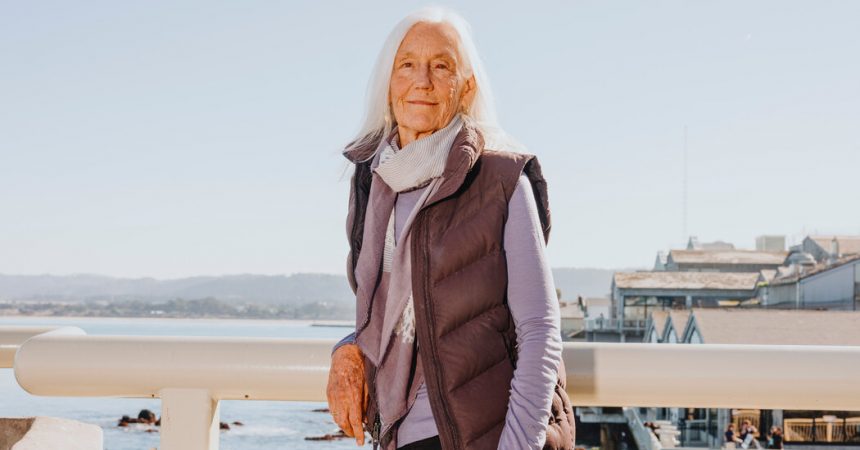Julie Packard, the marine biologist who has presided over the Monterey Bay Aquarium since it opened in 1984 and shepherded it through the Covid pandemic, announced her retirement as executive director on Wednesday. Ms. Packard has helped repurpose the thick-glassed fish museums of old into potent forces for ocean conservation action.
Built with a $55 million donation by her parents, David and Lucile Packard of the tech giant Hewlett-Packard, the aquarium has received tens of millions of visitors. Sightseers at the aquarium, a Northern California institution, have taken in a number of world firsts: the successful exhibition and release of great white sharks; the reintroduction of orphaned Southern sea otter pups to the wild; and the large-scale display of creatures such as salmon snailfish and vampire squid, found far below the reach of sunlight in a region known as the midnight zone.
At a time when rising ocean temperatures are altering water chemistry, changing fish migration patterns and making marine life more susceptible to the effects of overfishing, Ms. Packard’s staff has demonstrated how to restore ocean health by reducing plastic pollution and raising awareness of environmentally sustainable seafood. The aquarium’s partner organization, the Monterey Bay Aquarium Research Institute, has developed and deployed robotic submersibles that are transforming how scientists explore the ocean.
A tall, gracious, casually elegant woman who wears her scholarship lightly, Ms. Packard has run the aquarium in a low-key, pragmatic way. “Like my father,” she said. This conversation has been condensed and edited for clarity.
Why are you retiring now?
Well, I’m not exactly retiring. I’m transitioning to a leadership role on the board of trustees. I decided that it’s a great time to hand over the reins to our next generation of leaders. We have a great team and are in a really good financial position.
What do you think you’ll miss most?
The day-to-day interactions with the scientists. Fortunately, as a board member, I’ll still run into people in the hallways who have just figured out how to breed some obscure animal that no one’s ever seen before. I love collaborating with passionate people who are really fired up about what they’re doing as much as I love seeing a child’s eyes light up at the sight of a giant sea bass or a bloodybelly comb jelly. Both give me great joy.
Your program of free admission to school groups has brought in millions of students. Are many of the children you encounter disappointed to learn that sponges don’t wear white shirts, red ties and brown, square pants?
SpongeBob! My own kids were part of the “Little Mermaid” generation, so I can’t say that I know the messaging associated with him. But I think he’s a cool guy.
What’s your favorite organism in the ocean?
It’s not an animal, it’s a plant.
Which plant?
Giant kelp. I researched seaweed ecology for my master’s degree. That’s a pretty obscure subject and might seem irrelevant. However, kelp is the underpinning of the aquarium.
Can you name your favorite ocean animal?
The mola mola, also known as the ocean sunfish. It’s an unlikely animal that swims very slowly, eats jellies and tiny, tiny organisms even though it’s the world’s heaviest bony fish. It’s an example of incredible adaptation: basically circular, while the anal and dorsal fins have evolved into these gigantic oars used for propulsion. You look at it and think, “That’s a fish designed by committee. How can it even swim?”
And if you could be any oceangoing creature. …
The ocean is a perilous place to be, so you’re either going to be prey or predator. I suppose that if you wanted to have a good likelihood of success, you’d probably want to be at the top of the food web. So I’d say a southern sea otter, although I’m not crazy about being in cold water myself.
What’s the otter program’s origin story?
Early on, we got involved in rescuing and caring for orphaned sea otter pups, but it was very difficult to keep them alive. It took many years to develop the techniques to be successful at that, but more importantly, to raise them in a way they could be released and succeed in the wild and do all the otter things that they need to do.
The aquarium is famous for pairing the pups with adult females who teach them how to groom and forage.
That was a big breakthrough because, no surprise, the female otter is a much better mom than a human trying to show an otter pup what to do.
Can surrogate otter moms care for multiple pups?
No, just one. Rosa, the pillar of our sea otter surrogacy program, lived a long and happy 24 years and nine months. She raised 15 stranded pups, which is another way of saying that she took some years off.
Have you ever become close to the aquarium’s nonhuman inhabitants?
I’m very inspired by Makana, the aquarium’s rescued Laysan albatross. She was part of our research program to recover some endangered albatross species in the Pacific, and during the course of it, she injured her wing. Albatrosses only visit land to breed and care for their chicks. Needless to say, they need to fly. So here you have an albatross that cannot fly. And so we agreed to take her on, and now she’s about 18.
Does the aquarium have a mission?
Yes, to inspire wonder in ocean life and get people to fall in love with it. The best exhibit is not in the aquarium; it’s what’s going on right offshore, broadening awareness of what the ocean is really all about. When we opened the aquarium, people thought the ocean was pristine and so big that humans could not possibly have an impact on it. We’ve now realized that’s not the case.
What do you consider the great successes of your tenure?
First and foremost, we have reached a whole lot of people — 73 million visitors to date, which is way beyond what we ever thought possible. We set out to show people what the oceans are really like — a vast array of different organisms and life-forms that mostly lay beneath the surface. Later, we layered in our conservation and education programs.
Three years ago, your Seafood Watch program recommended that consumers avoid buying lobsters from Canadian and U.S. fisheries that use gear that risks entanglement with the endangered North Atlantic right whale. Were you surprised when five Maine lobstermen’s groups filed a defamation lawsuit against the aquarium?
We’ve been advised by counsel not to comment since the litigation is still active.
You’re known in aquarium circles for actively promoting and supporting the advancement of women into senior management roles.
Five of the six members of our executive team are female.
What position does the token male hold?
Deputy director.
As human societies evolve, so do the challenges they face. At the aquarium, how does that dynamic come into play?
Science isn’t just facts; it’s a continual process of discovery. The more we discover, the more we know we don’t understand.
In the beginning, we worried about how we were going to keep some weird, previously unseen invertebrate alive. But I quickly realized that the most challenging species in the aquarium isn’t on the wet side. It’s on the dry side: It’s us. How are we going to engage our audience and get them to care about and want to know more about and do more on behalf of the animals and the ocean when we all act in our own self interests?
That remains the big challenge for humanity.





